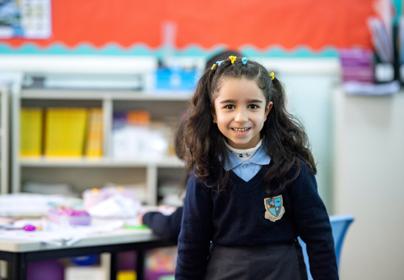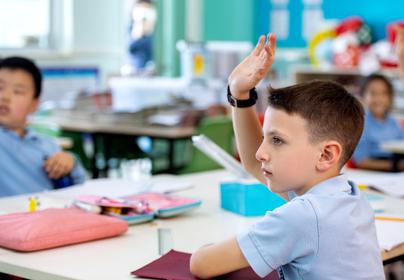在上海不列颠英国学校的早期教育部,尤其是在幼儿部,早期双语教育是一个强有力的理念。孩子们常被比作海绵,从周围环境中吸收语言。对于成人、看护者和教育工作者来说,确保孩子们吸收与其发展相适应的语言至关重要。在幼儿时期,儿童的大脑表现出高度的可塑性,能够快速适应。学习两种语言有助于建立复杂的神经通路,从而增强认知能力。
在上海不列颠英国学校,我们认识到双语和多语学习者的重要性。双语能力,即能流利使用两种语言,带来了诸多益处。双语家庭可以与远亲建立牢固的联系,促进社区参与,并帮助孩子欣赏自己的文化遗产,这对于塑造个人身份至关重要。零至五岁学习两种语言的儿童被称为双语学习者。双语学习者通常通过与看护者和同伴的关系来习得语言。高质量的互动和有意义的中英双语课程设置对他们的发展至关重要。受诸如时机和语言环境接触等因素的影响,年幼的双语学习者可能同时或按顺序学习语言。每个孩子的个性、动机和兴趣也在他们的语言学习历程中扮演重要角色。
研究表明,发展两种语言能带来社交情感方面的优势,例如改善自我控制能力和用第二语言建立友谊的能力。认知方面的益处包括增强执行功能、更好的专注力以及提高逻辑推理能力。早期读写技能也得到丰富,使得知识能够在语言间迁移。

英国早期基础教育体系是我们不列颠英国学校教学方法的基础,在此框架内,"沟通与语言"、"读写"以及"个人、社会与情感发展"是双语能力得以蓬勃发展的核心领域。我们鼓励孩子们认真倾听、清晰地表达自己,并通过故事、歌曲和角色扮演来拓展他们的词汇量——这些技能可以通过多种语言得到强化。该课程体系也重视儿童的文化资本,认识到双语和多语学习经历能为他们的学习之旅带来丰富的内涵。通过将双语实践嵌入早期教育课程,我们确保孩子们有机会培养自信、韧性和创造力。我们支持他们在不同语言之间建立联系,迁移语音意识,并为早期读写能力奠定坚实的基础。
与此同时,我们在早期教育课堂中践行"好奇心教学法"。这种方法重视真实、开放的资源、平静且富有启发性的环境以及儿童主导的探索。对于双语学习者来说,"好奇心教学法"尤其有效,因为它为孩子们创造了自然的语言交流机会,让他们能够通过合作、角色扮演和探索周围的世界来学习不同的语言。我们鼓励孩子们在游戏中使用真实的材料和有意义的情境来分享他们的母语。例如,在角色扮演区设立一个市场摊位或家庭厨房,可以让孩子们自然地切换语言,从而提高语言流利度和自信心。通过弘扬多样性并重视每个孩子的文化背景,“好奇心方法”帮助孩子们认识到自己是有能力、独一无二的个体,是更广阔的全球社区的一部分。
为了支持双语儿童,家长可以提供第二语言的资源,如书籍和音乐,并参与社区活动。在上海不列颠英国学校,我们鼓励家庭在保留母语的同时,将英语作为学校生活的语言。这种双重承诺不仅支持语言发展,也滋养了儿童的身份认同、归属感和幸福感。通过将早期教育课程与"好奇心教学法"相结合,我们为双语能力的蓬勃发展提供了一个全面且鼓舞人心的环境。我们与家长携手,致力于培养孩子们的批判性思维能力、丰富的词汇量和对沟通的热爱——培养自信、好奇心强、随时准备在互联互通的世界中探索的全球公民。

中班的孩子们很喜欢与朋友们分享他们的假期经历。让他们谈论自己的冒险故事并看到来自世界不同地方的照片总是非常美妙。感谢那些慷慨地寄来节日照片的家庭。本周我们开始学习关于家庭的知识,并阅读了《猫头鹰宝宝》。我们鼓励孩子们使用完整的句子结构,例如"这是我的……"或"我喜欢和我的家人一起……"。在数学方面,孩子们正在探索数字 1、2 和 3 的不同表征形式。他们学习了将数字名称与数字和数量进行匹配,数着不同排列方式的物品,并在数数时仔细触摸每件物品。
在小班,我们非常享受聆听孩子们讲述假期冒险经历的时光。感谢所有分享照片的人,这些照片为孩子们提供了一个绝佳的机会,让他们能够非常自豪地展示自己的图片并讲述自己的故事。本周,我们开始阅读茱莉亚·唐纳森的《咕噜牛》,看到孩子们被这个故事深深吸引,我们感到非常惊喜。我们一起学习新的描述性词汇,让角色和场景栩栩如生,丰富了孩子们的词汇量,激发了孩子们的想象力。
托班的孩子们热切地开始探索"我的大后院",重点关注种子、土壤、泥土中的虫子以及种植的乐趣。他们体验了亲手种植豆子带来的快乐,并在我们的生态花园里度过了更多时光。我们本周的故事,洛伊丝·埃勒特的《种植彩虹》,激发了孩子们对花朵和种子颜色的好奇心。生动的插图鼓励孩子们观察大自然的美丽,并讨论在我们花园中发现的不同颜色和形状。这是充满发现、动手学习和快乐探索的一周,孩子们沉浸在自然世界的奇妙之中。




